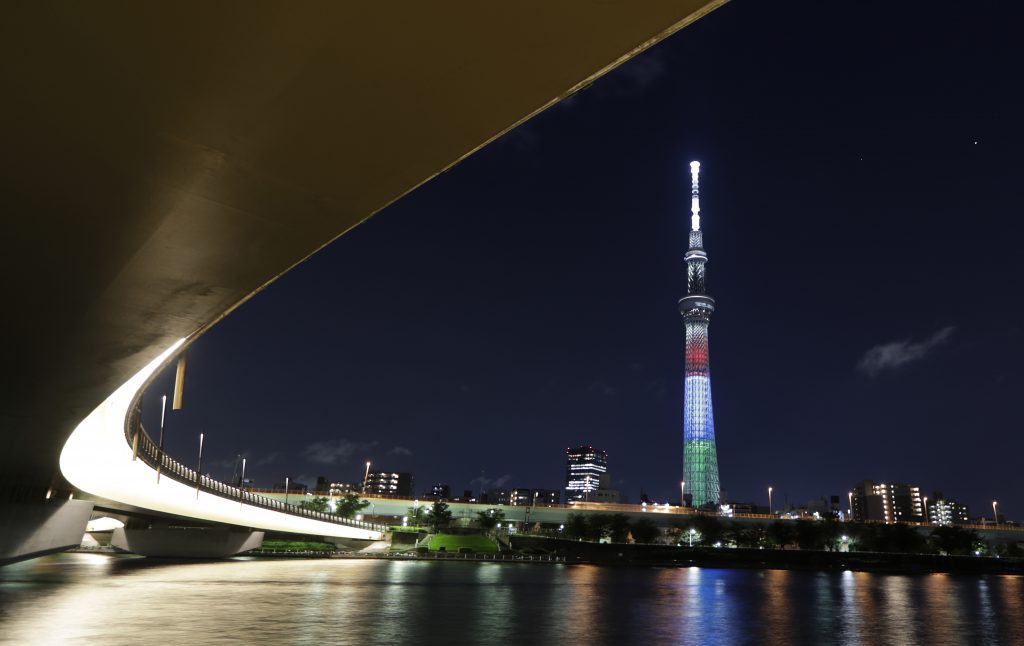
- ARAB NEWS
- 18 Jul 2025

TOKYO: Tokyo Skytree, which celebrated its 10th anniversary of its opening to the general public in May, has established itself as a landmark in the Japanese capital, putting an imprint on the skyline of the metropolis.
The cumulative number of visitors to Tokyo Skytree Town, which consists of the 634-meter structure and adjacent commercial and other facilities, reached about 315 million at the end of that month.
This autumn, a special lighting event featuring designs chosen by a public contest is scheduled to be held.
Located in Sumida Ward, Tokyo Skytree is the world’s tallest self-sustaining broadcasting tower.
To help accommodate the launch of digital terrestrial broadcasting in Japan, Tokyo Skytree was planned to take over the functions of iconic Tokyo Tower in Minato Ward. After 15 areas applied to host the new facility, Sumida Ward won the bidding. Under a collaborative project with Tobu Railway Co., Tokyo Skytree was built at a site formerly occupied by a cargo yard of the company.
The name of the tower was chosen by a nationwide vote on proposals collected through public invitation, and construction started in July 2008. The tower was jolted by shaking of upper 5 on the Japanese seismic intensity scale of 7 in the March 11, 2011, earthquake, but there was no effect on its structure. Construction work continued, and the tower reached the planned height seven days later. When it opened in May 2012, some viewed the structure as a symbol of disaster reconstruction efforts.
In the first year after its opening, the number of visitors to Tokyo Skytree Town totaled about 50.8 million, nearly 60 pct higher than had been expected. Since then, the complex has attracted more than 30 million people from Japan and overseas annually, solidifying its presence as a symbol of Tokyo.
Since the tower’s opening, the operators have been placing weight on cooperation with local communities. Before the novel coronavirus pandemic, a mascot festival was held every May in partnership with the Sumida ward office, local shopping districts and tourist associations. Nearly 100 “yurukyara” local mascots from across the country performed on special stages set up at the complex and nearby shopping streets, attracting more than 100,000 visitors in two days.
In June 2020, a railway bridge over the Sumida River was supplemented by Sumida Riverwalk, a pedestrian overpass that allows tourists and other people to cover the shortest distance between the Asakusa tourist area and Tokyo Skytree Town on foot.
After Tokyo was selected as the host of the 2020 Summer Olympic and Paralympic Games, work to boost lighting capacity started in May 2019. With 287 new units of lighting equipment, the antenna section at the top of Tokyo Skytree became visible from Tokyo International Airport at Haneda, located 20 kilometers away.
The regular lighting designs of “iki,” “miyabi” and “nobori,” designed to represent the spirit of Edo, the former name of Tokyo, Edo’s aesthetics and its bustle, respectively, have been renovated to make them look more dynamic.
Special lighting designs are also popular. By July this year, about 150 designs had been on display, including “meika,” reflecting feelings for disaster-stricken areas, and “hanabi,” themed on the annual Sumida River fireworks festival, which was canceled for three straight years due to the pandemic.
In addition, proposals for lighting designs to commemorate the 10th anniversary were solicited from April to August. The 10 best designs will be on display from Oct. 21.
Hiroyuki Ami, a senior official of Tokyo Skytree Town’s public relations office, remembers the time when the tower opened. “Many people came to take a look at the tower while it was still under construction. (The area) was full of life,” he recalled.
According to Ami, on the occasion of the 10th anniversary, one message read: “We got married on the opening day, so it’s also been 10 years for us. We now have a child.”
“Many people see their own growth in what is Tokyo Skytree today or consider the tower to be a place of memories. I want it to remain a beloved tower and symbol of Japan,” Ami said.
JIJI Press